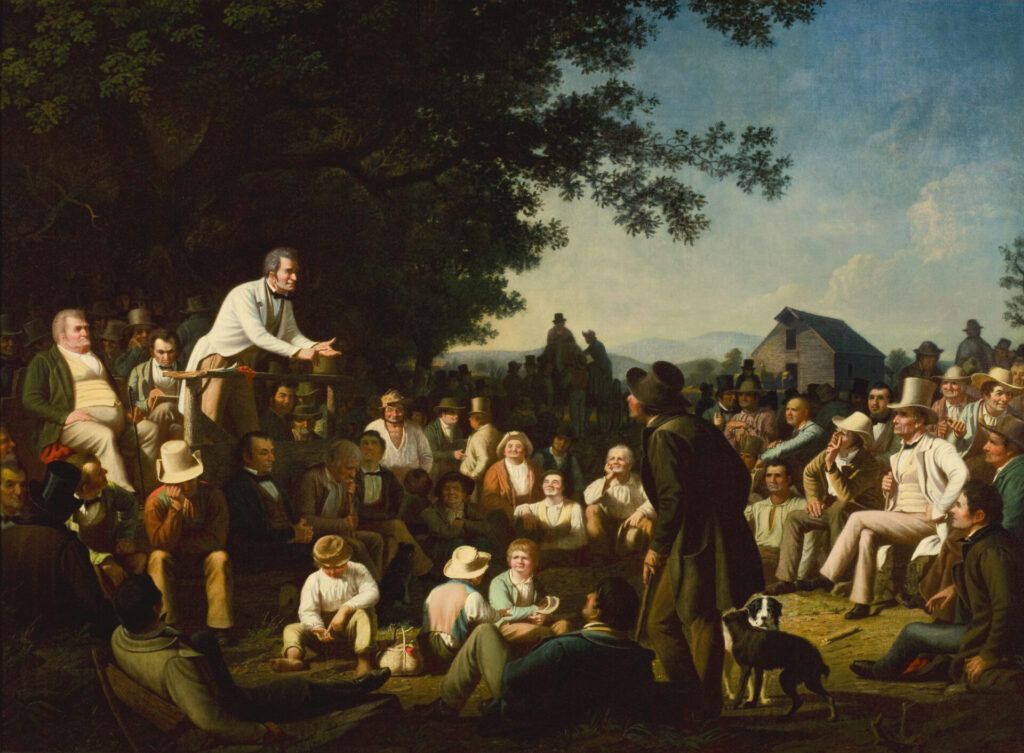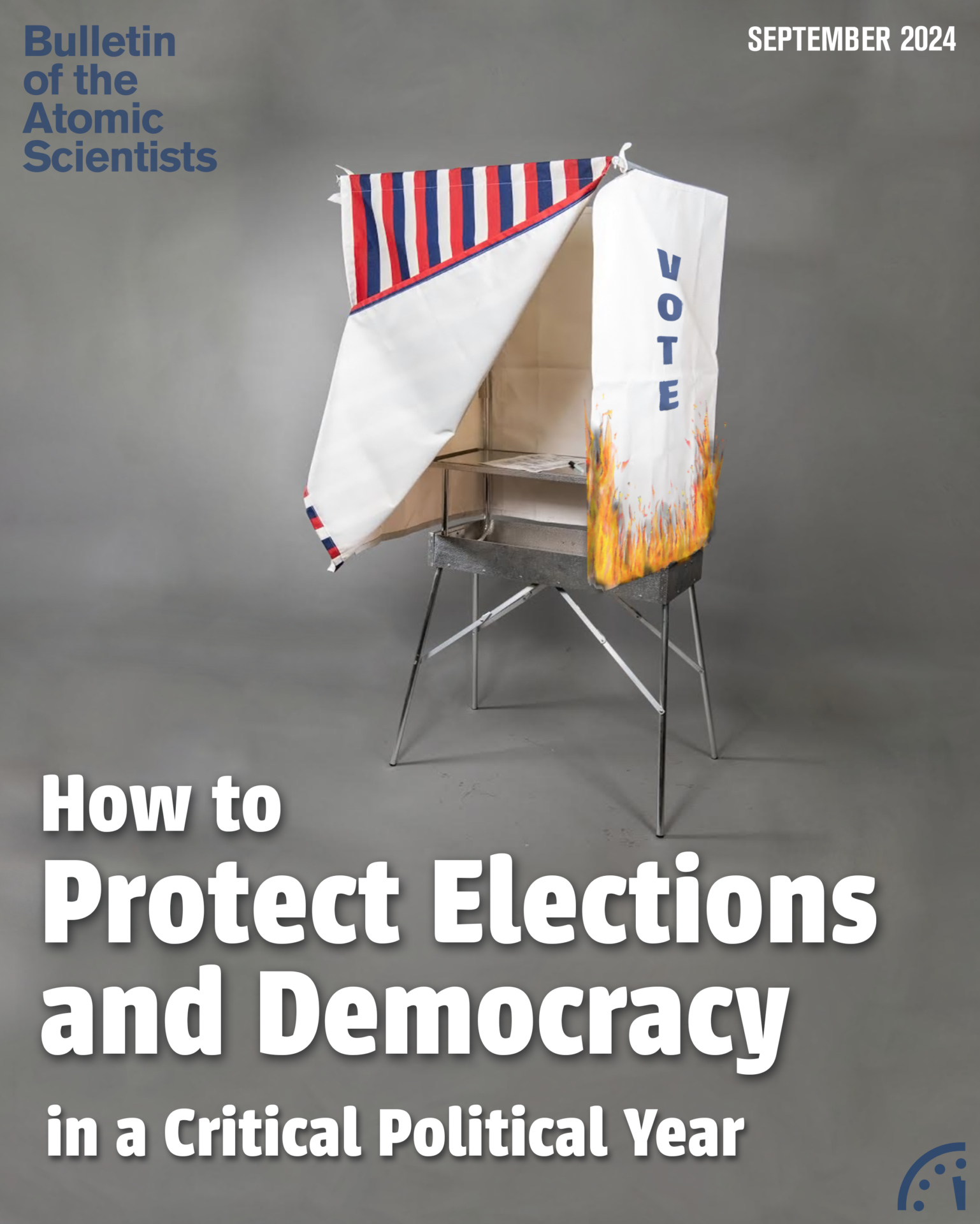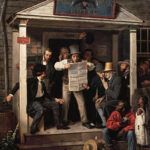The path to compulsory voting
By Aidan Calvelli | September 5, 2024
The path to compulsory voting
By Aidan Calvelli | September 5, 2024
More Americans voted in the 2020 presidential election than in any other contest in our history (Hartig et al 2023). Yet in the same election—the lauded peak of our democratic participation—nearly the same number of eligible voters stayed home as those who voted for the winner. If “Didn’t Vote” was a candidate, it would have essentially tied with Joe Biden.
This statistic is just the latest evidence of low American voter participation. Rarely since 1900 have more than 60 percent of US voters cast a ballot in the presidential elections. Congressional midterms are worse, with so-called “record” turnout rates even when most eligible people don’t vote (FairVote). State and local races lag even further: Despite abundant opportunity—the United States is estimated to have 519,000 elected positions—many of these offices are filled after races where barely any of the eligible electorate shows up (Lawless 2011).
An array of factors shape voter turnout rates (Vinayaka 2023). But many countries try to battle this trend with a simple solution: Require everyone to vote. Around two dozen countries—mostly in Europe, and most famously in Australia—have adopted a version of compulsory voting. Many compulsory voting countries impose a small civil fine for non-voters who lack a sufficient excuse; in Australia, for example, the average fine is about 50 Australian dollars (currently equal to about 32 US dollars), though fines vary by geography and whether one has failed to vote before. Other jurisdictions have text that make voting a duty but do not impose penalties for noncompliance.
Evidence from these countries confirms that simple sometimes succeeds. Turnout in Australia usually exceeds 90 percent. Across the range of adopting countries, turnout rose significantly thanks to this policy (Singh 2021). High turnout, of course, is not due solely compulsory voting; other factors, ranging from ease of ballot access to political culture to individual psychology affect ultimate turnout numbers. Still, if the United States saw even part of the average increase from mandating voting, it would mean millions of new voters.
No jurisdiction in America, however, takes this approach, leaving the idea long relegated only to the wish lists of “good-government reformers” (sometimes derided as “goo-goos”). Recently, though, as our crises of democracy have deepened, compulsory voting has moved closer to the mainstream. President Obama floated it near the end of his term. Think tanks and popular commentators seized on the idea’s democratic implications, rebranding it as “civic duty voting” to appease Americans’ aversion to mandates (Dionne & Rapoport 2022). And in the past two years alone, legislators in five states and in the US Congress have introduced bills to implement compulsory voting; some of these propose a small civil fine, while others would impose no penalty, instead aiming to legally convey that voting is a duty (Calvelli 2024).
This momentum should be inspiring for those who believe in democratic participation. Though compulsory voting is no panacea, it would ensure that more citizens make their voices heard. As more Americans get involved in politics, we move closer to the ideal of a fully representative democracy.
I, for one, buy that argument. Many college-educated liberals—the likely demographic of those reading this article—might too. If the goal of compulsory voting advocates is to win a debating contest, convincing this audience might be enough. If, however, the goal is to move compulsory voting from pie-in-the-sky proposal to enacted policy, it won’t be.
Reaching that harder goal will require resolving a core tension that reformers face: The same crises of democracy that inspire them to pitch compulsory voting inspire others to lose trust in democracy itself. As our government gridlocks and our civic culture crashes, more Americans than ever are skeptical that their self-governing experiment is all it’s cracked up to be. Advocates for compulsory voting won’t win by wishing away this crisis of confidence. To win, they’ll need to convince a dubious public that the problem with our democracy isn’t too much of it, but not enough.
The limits of an appeal to the word “democracy”
Compulsory voting advocates are right to relish their policy debate going public. They should also be honest about how political trends could stop that momentum. One might think that in the self-proclaimed birthplace of modern democracy, a pitch for everyone to have a vote would make for a potent political rallying cry. Judges and politicians trumpet that the vote is a “fundamental right,” the heritage of hard-won battles for a more perfect democracy. Shouldn’t everyone want their fellow citizens to use this American birthright?
That’s far from clear. In the encouraging column, Americans still largely say they love democracy. In the 2024 election, for example, as in 2020 and 2022, many voters cite “democracy” as a leading concern (Bump 2024). That enthusiasm for an abstract idea is encouraging, especially for democracy reformers who often struggle to make their case, even when—like reforming campaign money or ending gerrymandering—the underlying ideas are popular. A 2021 survey even found that 51 percent of Americans thought it was either very or somewhat important to make voting mandatory (Connaughton & Schumacher 2021).
Lurking beneath this support, however, is the uncomfortable reality that beliefs in democracy are splintering—limiting its persuasive power. Sixty-eight percent of Americans in fact, are dissatisfied with how democracy is working (Wike & Fetterolf 2024). Other measures are similarly grim. To gain traction, then, compulsory voting advocates must take these trends seriously. It won’t be enough just to say that more voting is good because more democracy is good. They’ll need to frame compulsory voting as a way to put American democracy back on track through more power in the hands of the people.
The 2024 presidential election has brought this challenge into focus. Before he dropped out, Joe Biden’s central campaign message had been about what he termed the “threat to our democracy” posed by Donald Trump (White House 2024). This pitch indicated two of Biden’s beliefs: first, that Americans would agree that Trump is a threat to democracy; and second, that they would base their votes on that belief. Both were and remain dubious.
Many voters agreed with Biden that protecting democracy should be a top concern. But few believed that Biden was their savior. Polls consistently showed that more voters trusted Trump to “protect democracy” (Itkowitz et al 2024). This result—for an aspiring “dictator” who rejects legitimate elections and sought to thwart the peaceful transfer of power—might seem confounding. But incredulity at voters’ beliefs tends not to be tactful politics. Those backing compulsory voting must accept that their idea of “democracy” might not be one most voters share. Among voters worried about democracy, Republicans tend to fear fraud—despite its virtual nonexistence—while Democrats worry about overturned elections (Fields & Sanders 2023). To pitch a policy as “good for democracy” is to avoid underlying disagreement about what that term means today. In today’s politics, appeals to “democracy” are far from self-evident.
As if this democratic disagreement weren’t difficult enough, deeper trends suggest profound disillusion with the concept of democracy itself. Just four years after the first real threat to the peaceful transition of power in the 250-year history of the United States, just five percent of voters rank January 6th as what they remember most about Trump’s presidency, far beyond “his behavior” (Zhang et al 2024). One survey suggests that 20 percent of Americans say they’ve given up on democracy as a form of government (Frankovic & Montgomery 2023). A full 80 percent of voters in both partisan camps believe their opponents will “destroy America” (Chinni 2022). A not-insignificant number even seem to accept political violence against opponents or other authoritarian calling cards (Goldman et al 2024). It’s certainly no guarantee that these democracy doubters see more democracy as the path forward.
Neither trend is comfortable. It’s far easier to believe that Americans share an attachment to liberal democratic ideals, a commitment they hold more strongly than any partisan preference. Such wishful thinking, though, is political malpractice. The same democratic crises that reformers see as the impetus for democracy renewal also act as rational reasons for voters to doubt the democratic experiment (Allen 2023). Winning Americans over to the idea of compulsory voting, then, will have to come from more than high-minded appeals to democratic duty. Advocates must roll up their sleeves to prove that more voting means more political power for the people.

A pitch for people power
If calls to defend “democracy” aren’t the rallying cry they once were, compulsory voting advocates will need a new sales pitch. The tension is that compulsory voting doesn’t radically reshape democratic systems; it takes what exists and brings more people in. How might a pitch for this move succeed? Not by abandoning democracy, nor through partisan self-interest. Instead, with a pitch that explains why the problems of our democracy come from having too little of it—and that when everyone votes, we all have more power.
The wrong path for this power-based argument for compulsory voting is a partisan one. Democrats—the party of every legislator to introduce the policy—have occasionally tried this, premised on the idea that low-income and minority voters are less likely to vote but more likely to vote Democratic. Republicans then predictably denounced compulsory voting as a power-grab. This fight polarized the policy, putting a ceiling on its coalition.
The larger problem, though, is that this premise is dubious. Provocative new research suggests that today’s Democratic Party is winning a greater number of upper-income and educated voters, who tend to have high turnout rates, while Republicans are steadily becoming the party of lower-class voters, who tend to vote less frequently (Stephanopoulos 2024a; Goidel et al 2023). Compulsory voting, at least nationally, might for this electorate be a pro-Republican reform; it at least would lack a clearly blue skew. Try, then, selling even the most principled pro-democracy Democratic officials on a policy that votes them out. Or try pitching a voting expansion to Republican elites weaned on the belief that pro-voting policies are political suicide. Either way, the pure partisan pitch looks stuck.
For a less partisan pitch, the uncertain impacts of compulsory voting might be its window of opportunity. Politicians are averse to uncertainty, but voters—especially in this anti-establishment climate—are more willing to take a risk (Epstein 2023). Into that window should slide arguments that expanding the electorate is an opportunity to fix democracy by putting everyday people in power. Indeed, advocates for compulsory voting have begun to make this shift, emphasizing not just the civic culture aspects of “100 percent democracy” but its practical political benefits (Dionne & Rapoport 2022). As advocates continue to do so, three arguments based in political interest warrant increased attention: an exit from polarization, more chances for persuasion, and more substantive accountability.
An exit from polarization
First, new voters push extreme partisans out of the political limelight, giving everyday voters a better chance to set a popular agenda. Though we lack a perfect picture of non-voters’ politics, what is known suggests that they are less ideological than the current electorate is (Knight Foundation 2020). (At the very least, it’s clear they don’t love any option enough to trek to the polls.) Knowing that these voters will no longer register their distaste through disengagement might change politicians’ calculus. Rather than harp on issues aimed at the loudest fraction of their base, they’ll have to highlight ideas with wider support. Mandatory voting nudges officials toward making government effective in ways that restore faith democracy can deliver (Pildes 2023).
More chances for persuasion
Second, new voters mean more room to make popular majorities matter. One of the great frustrations of our politics is how common it is for popular ideas to be cast into political dustbins (Cottom 2024). Why labor to convince fellow citizens of the justice of your idea when our minoritarian government will ignore you? While compulsory voting can’t fix all our majoritarian deficits, it could narrow the gap between what voters think and what the broader population thinks (Stephanopoulos 2024b). Less easily could candidates win by selectively turning out supporters (or, worse, suppressing opponents). Nor could they claim support of silent majorities when each cycle requires, in essence, majorities to speak. Compulsory voting could thus give new life to the lost art of political persuasion.
Fuller accountability
Third, full turnout means fuller representation—and the power that comes with it. A recurring frustration with American politics is how unresponsive it is to regular citizens’ preferences. Your views are far more likely to reflect government policy if you happen to be rich and white (Page & Gilens 2017). Part of that effect comes from the demographics of wealth and the firehose of money in politics. Part, though, may come from an unrepresentative electorate. Specifically, low turnout is not concentrated equally among demographic groups; the actual electorate, in fact, tends to be much richer and whiter than the eligible electorate as a whole (Lo Wang 2024; McElwee 2014). Compulsory voting, then, by aiming to narrow that distortion, can be a path to increased influence for workers and voters of color. That’s a different argument than democracy in an abstract sense of representation. It’s democracy as a practical path to political equality—a form of government we should back precisely because it pushes towards policies that empower people now neglected.
These effects are far from guaranteed. Evidence from neither political theory nor experience abroad depicts the policy as a panacea (Brennan & Hill 2014). So, pitching compulsory voting as a silver bullet is a recipe for disappointment. But it has the potential to be one source of democratic renewal, a way not just to get more people to vote, but for those votes—and the voices they represent—to better count. Making that interest-based argument gives mandatory voting its best shot.
The path to victory
Even if these ideas expand compulsory voting’s base, that’s only half the battle. (Making policy is hard.) Advocates need a path from idea to enactment. That route has its widest berth through the states, capitalizing on their direct democracy outlets and the potential for local interest group mobilization.
Especially during a presidential campaign, so much political attention turns national. Compulsory voting advocates would do well to resist the temptation. In recent years, while the Senate filibuster has stalled most national democracy legislation, the states have shown real reform promise. Eight states have created their own “voting rights acts,” supplementing their federal cousin with new voter protections (Greenwood & Stephanopoulos 2023). Places from Maine to New York City are experimenting with “ranked choice voting” or other pro-majoritarian election systems (Parks 2023). And a handful of states have curbed partisan gerrymandering with independent redistricting commissions (Leaverton 2022).
While some of these changes have come through the legislature, Schoolhouse-Rock style, many are the product of “direct democracy” channels like the initiatives and referendums that our national politics lack (Boldt 2023). Here, voters make a case directly to other voters—crucial for a compulsory voting policy that might struggle to win over elected partisans. (Politicians tend to like the electorate that elected them.) By going straight to the people, compulsory voting campaigns reinforce the purpose behind the policy: that we should want the voters themselves to have a say.
How can advocates take these ideas to the people effectively? Successful initiative campaigns require not just good ideas but good organizing, with goo-goos building partnerships with community groups capable of giving democracy issues kitchen-table resonance. Unions, for example, can be key partners, reaching working-class voters with the message that a new electorate will understand their economic concerns (Andrias 2024). Racial justice groups could explain the way that compulsory voting minimizes voter suppression and makes politicians accountable to more voters of color (Yankah 2021). Scores of other organizations can help too—as long as advocates get good at linking democratic ideals with the popular policies they support. Getting so substantive—in other words, pitching voting not just for its own sake, but as a path to political influence—doesn’t make democracy partisan; it affirms the need for popular rule.

The future
There’s no denying that compulsory voting advocates face an uphill battle. Yet they should take heart that we have been here before. Compulsory voting is not the sole province of faraway Australians; it’s an idea with deep American roots. After a smattering of early laws—six of the original 13 colonies had a proto-form of compulsory voting—energy for the policy spiked in the Progressive Era. From 1880 to 1920, amid a wave of democracy reforms, activists brought the debate to over a dozen state legislatures, four constitutional conventions, and countless popular articles (Calvelli 2024; Abraham 1952. They even had some success: Kansas City briefly mandated voting in the 1890s (Ela 2023), while North Dakota and Massachusetts constitutionalized the power to do so. Though momentum stalled there, American across the country were swept into confronting a question: In a government by the people, shouldn’t we hear from all of them?
Today’s advocates have a chance to build on what these predecessors started. Though these earlier advocates were flawed—doing little to address racial and gender barriers to voting—and ultimately fell short, their example teaches that democracy renewal can seem impossible until it isn’t. With the right mix of ideas and interests, Americans might soon see how a full-turnout democracy works.
Together, we make the world safer.
The Bulletin elevates expert voices above the noise. But as an independent nonprofit organization, our operations depend on the support of readers like you. Help us continue to deliver quality journalism that holds leaders accountable. Your support of our work at any level is important. In return, we promise our coverage will be understandable, influential, vigilant, solution-oriented, and fair-minded. Together we can make a difference.
Keywords: 2024 election, Elections, class, compulsory voting, democracy, inequality, mandatory voting, polarization
Topics: Special Topics




















